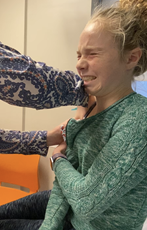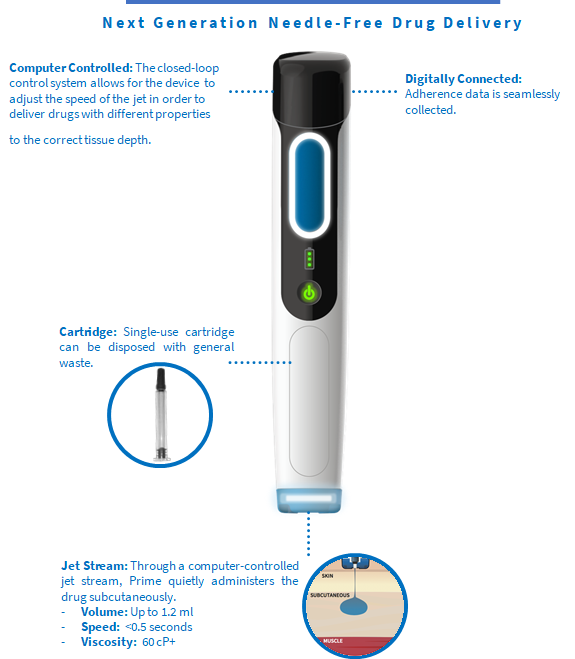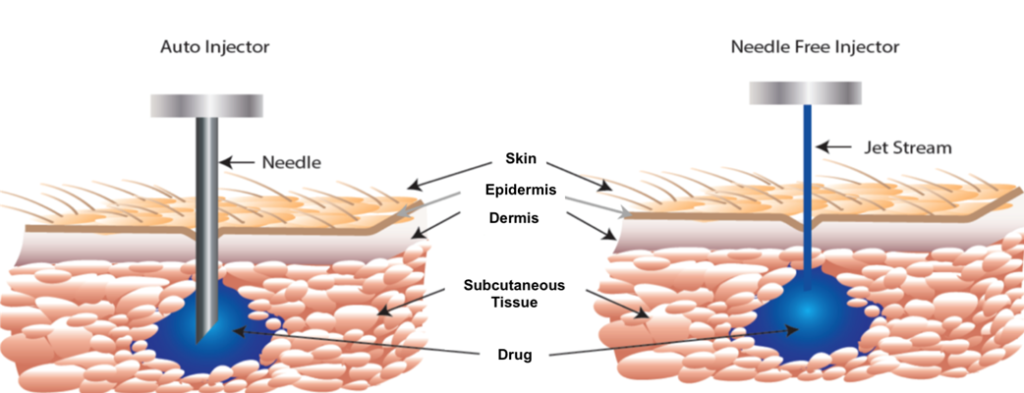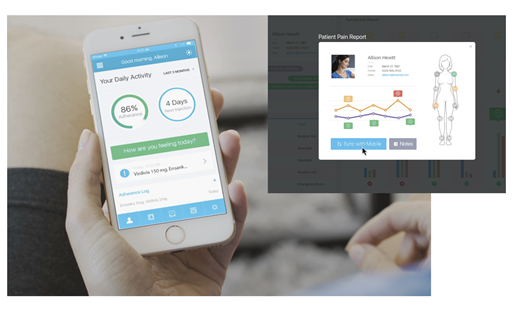Citation: Taylor B, “An Injection of Needle-Free Innovation”. ONdrugDelivery Magazine, Issue 103 (Dec 2019), pp 28-30.
Barb Taylor discusses the next generation of needle-free injection devices, which incorporate connectivity.
It’s that time of year again – turkey feasts, holiday songs, festive parties… and the flu! While I am a strong believer in all vaccinations, I will secretly admit that sometimes the kids (due to their anxiety, fear and complaining) win and we skip the flu jab. But this year, with my parents’ health not 100%, the flu shot was non-negotiable.
“Portal is reinventing needle-free drug delivery with technology that is substantially different from any other needle-free injector that has been on the market.”
As we sat in the waiting room at the paediatric clinic, my kids naturally brought up my work and asked when they could get a needle-free shot from Portal. The nurse, who was fast and efficient but looking rather harried, overheard us and asked if it worked. The quick answer is yes, it works. But you can’t get the shot (or the injector) for your own use from Portal – it will be distributed through our pharma partners as part of a combination device with an approved drug.

Figure 1: Flu vaccine time.
The nurse continued to recount a tale I have heard many a time. The anticipation of the injection is usually worse than the actual shot (Figure 1). But that fear can often be debilitating and the difference between a successful vaccination and an unsuccessful one. She guessed that 5-10% of patients don’t come in for the influenza vaccine because of the struggle and anxiety of having to get a shot. A 2012 paper by Taddio et al1 shows her guess is not far off – a survey of parents (n = 883) and children (n = 1024) found that “altogether, 24% of parents and 63% of children reported a fear of needles. Needle fear was the primary reason for immunisation non-compliance for 7% and 8% of parents and children, respectively”. I am not alone.
PORTAL PRIME DEVICE – NEXT-GENERATION NEEDLE-FREE
Our nurse continued to tell another story of nasal spray flu vaccines and other needle-free injectors she had seen over her career – and her ambivalence towards them. My quick answer was that Portal Instruments is reinventing needle-free drug delivery with technology that is substantially different from any other needle-free injector that has been on the market.

Figure 2: The Prime device offers next-generation, connected needle-free drug delivery.
Here’s the long answer as to what that means and how Portal is different – Portal Instruments is modernising drug delivery by using novel, electromechanical technology to deliver and track injections, needle-free and automatically. Portal’s injector, called Prime (Figure 2), administers the drug through a highly pressurised, computer-controlled jet stream. The narrow jet pierces through the epidermis and delivers the drug into the subcutaneous space (Figure 3).

Figure 3: Conventional needle-based injection from an autoinjector (left), compared with needle-free injection (right) where a
high-pressure, narrow jet pierces through the epidermis, delivering drug into the subcutaneous space.
This is different from mechanical needle-free injectors as Prime’s computer-controlled motor and internal feedback control system work together to sense the pressure and adjust the velocity of the jet stream accordingly. This results in a very quick injection (<0.5 seconds) even at high volumes (1 mL) and high viscosities (tested up to 60 cP).
CONNECTIVITY & ANALYSIS TO DRIVE OUTCOMES

Figure 4: Example of patient and physician health portals.
As with most next-generation technologies, the Prime needle-free device logs all injection sand can be automatically connected to patient apps or physician records (Figure 4).
Portal’s vision is for this data to provide real-time adherence insights which can ultimately be used by the healthcare team to drive improved adherence and better outcomes. For example:
- Pharmaceutical partners can analyse aggregated and de-identified data to enhance pharma lifecycle management and use the quantitative insights to launch specific, targeted campaigns to drive population penetration and adherence programmes.
- Patient service providers can quickly identify “late doses” before they become “missed doses” and be proactive in reaching out to patients who may need support.
- Payers could use this adherence data to inform value-based contracts that are dependent on adherence.
With data and analysis, teams will be able to identify challenges related to adherence, predict trends in patient populations, and use that data to create a better patient experience. Trends that were previously undetected may become noticeable.
Likewise, our vision is that connectivity within the injector will empower patients to have better control over their treatments. Patients can track their injections and other variables to improve their ability to self-manage their disease. If patients share their data feeds with caregivers or family members, those family members can remotely and non-intrusively check to make sure the medication was taken on time and offer support if needed. Patients may choose to share injection and self-reported data with their physicians in order to have a more well-rounded picture of their disease progression. This insight may create more efficient physician visits and more tailored treatment plans.
A VISION FOR THE FUTURE
While I reflect on how a needle-free vaccine would be great for my family, I cannot help but think of patients who need to have injections monthly, weekly or daily. In this season of thanks and reflections, I am indeed grateful for the many advances in pharma therapies and drug delivery devices that can improve, empower and ease the journey for patients.
REFERENCE
- Taddio A et al, “Survey of the prevalence of immunization noncompliance due to needle fears in children and adults”. Vaccine, 2012, Vol 30 (32), pp 4807–4812.


